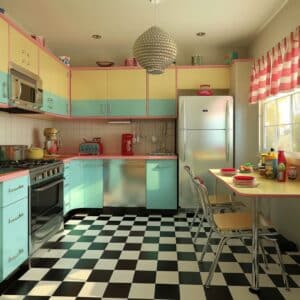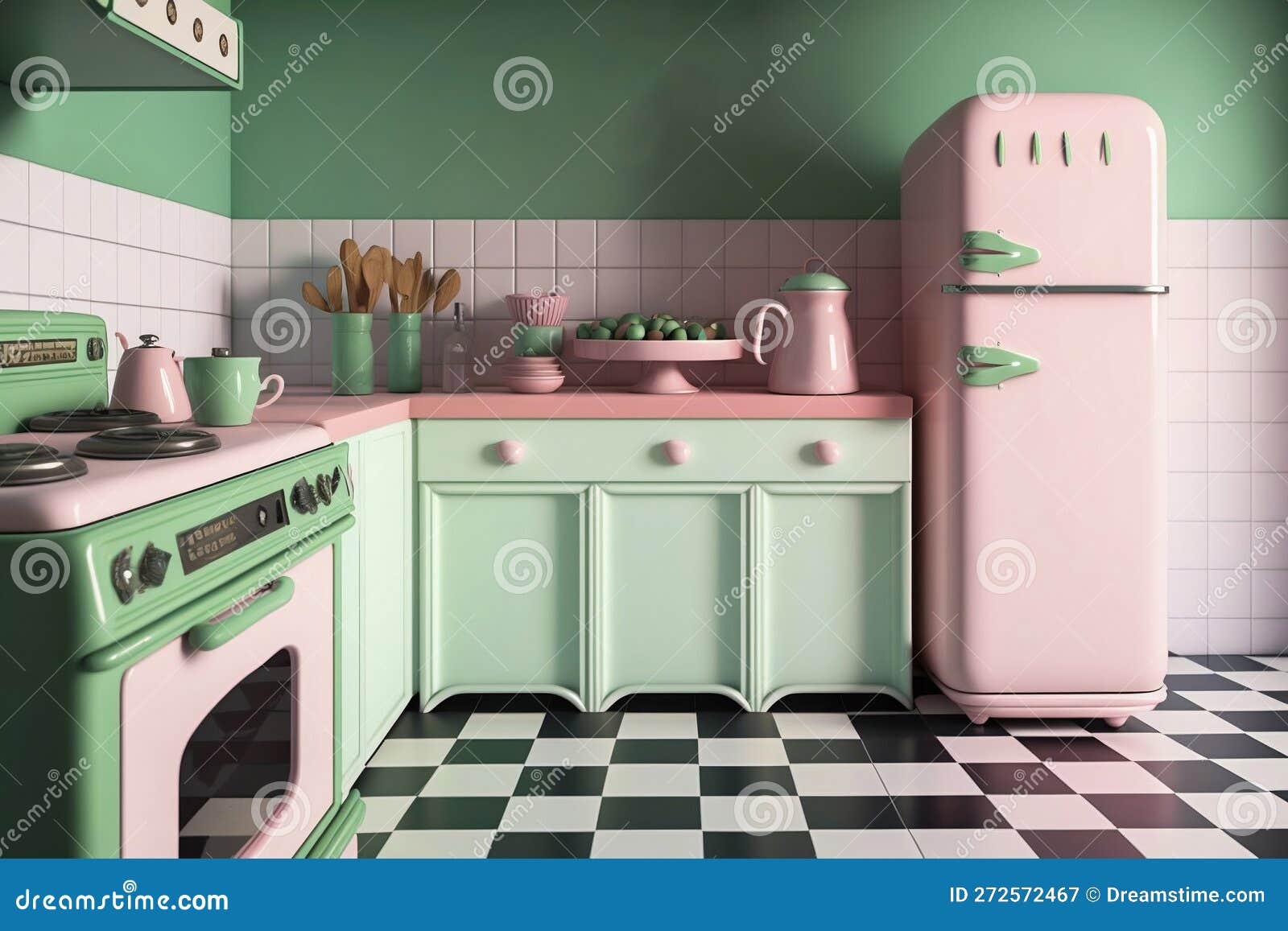Groovy Kitchens: A Blast From the Past?
Groovy Kitchens: A Blast From the Past?
Stepping back in time can be incredibly inspiring, especially when it comes to design. The 1960s, a decade of bold change and vibrant energy, left a lasting legacy on interior design. And nowhere is that more evident than in the kitchen. Forget sterile minimalism; the 60s kitchen was a statement – a playful explosion of color, form, and function that's making a major comeback. This isn't just about nostalgia; it's about embracing a retro aesthetic with a modern twist. Let's delve into the groovy world of 1960s kitchen design and see how you can incorporate its iconic style into your home.
The Vibe: More Than Just a Retro Look
The 1960s kitchen wasn't just about aesthetics; it reflected the societal shifts of the era. Think of it as a microcosm of the decade's optimism and forward-thinking attitude. The space was meant to be functional, yes, but also fun, sociable, and incredibly stylish. Key elements include:
- Bold Colors: Forget muted tones. Think vibrant oranges, sunny yellows, avocado greens, and shocking pinks. These weren't just accent colors; they were the stars of the show.
- Geometric Patterns: Think dynamic shapes, stripes, and playful prints adorning everything from countertops to backsplashes. This was a period of graphic design experimentation, and the kitchen was a perfect canvas.
- Space-Age Influences: The burgeoning space race fueled a fascination with futuristic forms and materials. Rounded edges, chrome accents, and sleek lines became signature elements.
- Open Concept (a nascent trend): While not fully realized as it is today, the 60s saw a move towards more open-plan kitchens, blurring the lines between cooking and living spaces.
Iconic Elements of a 60s Kitchen: A Visual Feast
Let's explore some specific design elements that truly captured the essence of the 1960s kitchen:
1. Cabinetry:
- Colors: Think bold primary colors, avocado green, harvest gold, or even a playful two-tone scheme.
- Materials: Laminate was king! Affordable and easy to clean, it came in an array of exciting colors and patterns. Wood cabinetry was also prevalent, often featuring simple, clean lines.
- Hardware: Look for sleek, brushed metal knobs and pulls, often in chrome or brass. Consider rounded shapes for a truly authentic touch.

2. Countertops:
- Laminate: Again, laminate reigned supreme. Its durability and affordability made it a practical choice, while its versatility allowed for a wide range of colors and patterns.
- Formica: A specific type of laminate, Formica became synonymous with 60s kitchens, offering an array of vibrant patterns and colors. It’s making a significant comeback today!
3. Appliances:

- Retro Refrigerators: Many 60s kitchens featured iconic, often oversized, refrigerators with rounded edges and colorful exteriors. Today, many manufacturers offer retro-styled refrigerators that capture the essence of this era.
- Built-in Ovens and Ranges: Built-in appliances were becoming increasingly popular, contributing to a cleaner, more streamlined look.
4. Backsplashes:
- Tiles: Ceramic tiles were popular, often in vibrant colors or geometric patterns, complementing the overall design scheme. Consider using smaller tiles to create a dynamic mosaic effect.
- Laminate: Laminate backsplashes offered a seamless, easy-to-clean surface and a wide array of color and pattern choices.

5. Flooring:
- Vinyl: Vinyl flooring was a practical and stylish choice, often featuring geometric patterns or bold colors. It was easy to clean and maintain.
- Linoleum: Similar to vinyl, linoleum offered a wide range of colors and designs.
Modernizing the Retro Look: Tips and Tricks

While embracing the 60s aesthetic, you don’t need to sacrifice modern functionality and convenience. Here are some tips for blending the retro with the contemporary:
1. The Power of Color: Don't be afraid to experiment with bold colors. Start with a statement wall or a vibrant backsplash. Balance the vibrancy with neutral elements like white or light wood cabinetry to prevent the space from feeling overwhelming.
2. Mix and Match: Combine retro elements with modern touches. Pair a vintage-inspired refrigerator with sleek stainless steel appliances. Mix laminate countertops with modern subway tiles for a unique blend.

3. Update Appliances: While embracing the retro aesthetic, ensure your appliances are energy-efficient and functional.
4. Lighting: Incorporate retro-inspired pendant lights or globe lights to add character and ambience. Combine these with under-cabinet lighting for a functional and stylish twist.
5. Accessorize: Add vintage-inspired accessories like retro-style canisters, colorful dish towels, and patterned placemats to complete the look.

Step-by-Step Guide to a Retro Kitchen Makeover
Ready to transform your kitchen? Follow these steps:
- Plan & Research: Browse online resources (like Pinterest!) and gather inspiration from 60s kitchen designs. Determine your budget and desired scope of the project.

-
Choose Your Color Palette: Select bold, vibrant colors that reflect the era. Consider using a color wheel to create a harmonious balance.
-
Select Cabinetry and Countertops: Explore options for retro-styled cabinetry, possibly incorporating laminate or opting for a modern take on vintage materials like wood. Choose countertops that complement your chosen colors and style.
-
Install Backsplashes and Flooring: Install backsplashes and flooring that match your chosen aesthetic. Tiles, laminate, and vinyl are all great options.

-
Appliance Selection: Choose appliances that blend modern functionality with retro aesthetics. Consider energy-efficient models.
-
Accessorize: Add retro-inspired accessories to complete the look and create the desired ambiance.
Beyond the Kitchen: Extending the Groovy Vibe

The 60s aesthetic isn't limited to the kitchen. Consider extending the groovy vibe to adjacent spaces:
- Dining Area: Use bold colors, geometric patterns, and retro lighting to create a cohesive look.
- Living Room: Incorporate mid-century modern furniture, vibrant textiles, and iconic design pieces.
Conclusion: Embracing the Past, Shaping the Future

The 1960s kitchen wasn’t just a place to cook; it was a reflection of the times – a bold, optimistic, and stylish space. By incorporating key elements of this iconic era into your own kitchen, you can create a space that is both visually stunning and deeply personal. It’s a testament to the timeless appeal of design and a reminder that even the most retro styles can find new life in the present. So, embrace the groovy vibes, and let your kitchen be a vibrant celebration of the past, present, and future!

